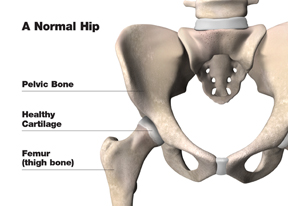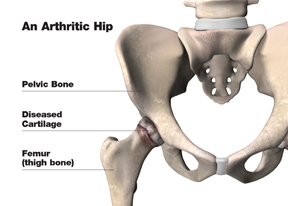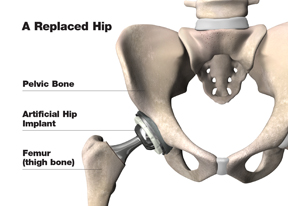Hip Anatomy and Function
How a Healthy Hip Works



The hip is one of the main weight-bearing joints in your body. It consists of two main parts:
- A ball (femoral head) at the top of your thighbone (femur)
- A rounded socket (acetabulum) in your pelvis
Ligaments, which are bands of tissue, connect the ball to the socket and help keep the ball and socket steady. A smooth, tough material called articular cartilage, which cushions the bones and lets them move easily, covers the surfaces of the ball and socket.
All the rest of the surfaces of the hip joint are covered by a thin, smooth tissue liner called synovial membrane, which makes a small amount of fluid that acts as a lubricant so that the bones in the hip joint will not rub against each other.
What causes hip pain?
Pain in your hip can be debilitating, making it difficult for you to walk, climb stairs, or even pick up an object from the floor. It can limit your freedom of movement and ability to function independently.
While hip pain can be caused by deformity or by direct injury, like trauma or a sports injury, the most common cause of hip pain is osteoarthritis (OA) also known as degenerative joint disease (DJD). Depending on factors like age, weight, joint function, and activity, people with arthritis find their hip’s cartilage lining wears away over time. At that point, your bones begin to rub against each other, resulting in friction, swelling, pain, stiffness, and instability.
Experiencing joint pain day after day without relief can lead to “staying off” the joint — which often weakens the muscles around it so it becomes even more difficult to move.
Your Treatment Options for Hip Pain
You don’t have to live with severe joint pain and the functional limitations it causes. If you have not experienced adequate results with medication and other conservative treatments, total joint replacement may provide the pain relief you long for, in addition to allowing you to return to the lifestyle and activities you enjoy. Your orthopaedic specialist can tell you whether you might benefit from joint replacement and explain the reasons why it may, or may not, be right for you.
Of course, even if your orthopaedic specialist determines that joint replacement is a good medical option for you, it is still up to you to make the final decision. The ultimate goal is for you to be as comfortable as possible, and that always means making the best decision for you based on your own individual needs.
About Total Hip Replacement
Hip replacement surgery involves replacing the femur (head of the thighbone) and the acetabulum (hip socket). Typically, the artificial ball with its stem is made of a strong metal or ceramic, and the artificial socket is made of polyethylene (a durable,wear-resistant plastic) or metal backed with a plastic liner. The artificial joint may be cemented in position or held securely in the bone without cement.
